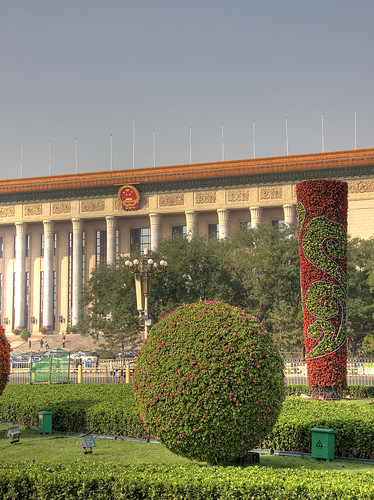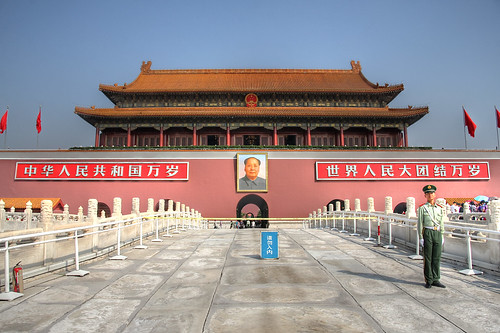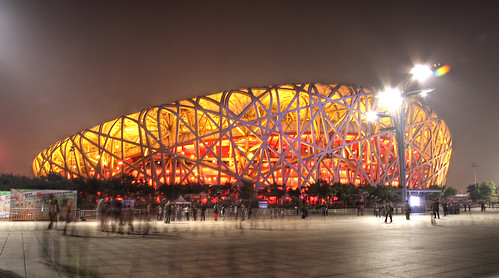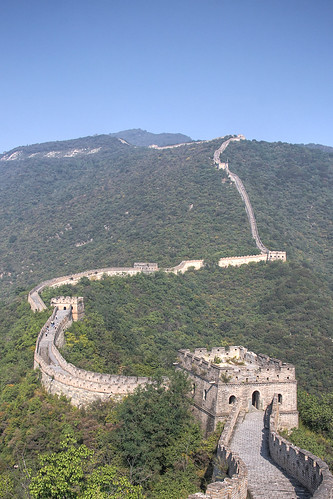After a successful presentation at the conference, we had the whole Friday and Saturday to discover Beijing. Probably all travel guides will tell you to arrive at sights as early in the morning as possible, because they all tend to get very crowded. So our first destination early on Friday morning was the Tiananmen Square and the Forbidden City. The best way to approach the world’s largest square is from Qianmen subway station. Although the events of 1989 are taboo and heavily censored in China, you can still feel the consequences of the student protest. Just to enter the square you have to go through security checks, for some sights you even have to get rid of any bags and every pocket is double-checked by guards. Additionally, the square is full of security cameras. Well, Beijing itself is full of cameras too, but at the Tiananmen Square the number of security cameras is even more pressing – most lanterns have 6 to 8 cameras gazing in every direction.
After passing the Qianmen gate, first we arrived at the Mao Mausoleum, which was built after the death of the leader Mao Zedon. His body was embalmed and is since then something every Chinese citizen has to see at least once in his life. Consequentially, the queue for having a glimpse at Mao Zedong is extremely long. On the day we visited the Tiananmen Square, the queue was about 1-1,5km long – it went several times along the building. Because we had also other plans for our day, we skipped the Mao Mausoleum and went on to the heavily guarded Monument to the People’s Heroes. The Tiananmen Square is enclosed by the Great Hall of the People in the west and the National Museum of China in the east. In the north, directly in front of the Tiananmen building, runs the Chang’an Jie street. The first east-west street was established already in 1267, today this street has grown to a length of 45km. Passing the street and the Tiananmen gate, we arrived in a huge inner courtyard. It was strange that right here in the historic center of the city we found several basketball courts. You can get a better view on the courtyard from the Tiananmen Gate itself, from where you have a nice view over the huge Tiananmen Square too.
After passing the Duan Men Gate we finally arrived at the Emperor’s Palace. The Forbidden City is a giant complex of several hundred mostly renovated buildings, huge inner courtyards, long corridors and many exhibitions about the life of the Chinese and their emperors (like emperor wedding ceremonies, weapons, jade art etc.). To see everything you would probably need 2 or 3 full days, although many walk only along the central pathway with the main buildings. Similarly to the Temple of Heaven, you can easily escape the crowds by leaving the central pathway on the left or right side, where there is still plenty to see. Spending a half day in the Forbidden City was enough for both of us, so we searched for some lunch around the Wangfujing Shopping Street. Here you can find shops of all well known labels and you can also get a real coffee, which is very hard to find in Beijing. The most interesting to me was the Wangfujing Snack Street, one of the last few streets serving traditional street food. Many food stands were serving anything from sea urchins and scorpions to steamed dumplings with various delicious fillings. This is a street you should not miss if you love street food and if you are open to discover new tastes.
In the late afternoon we went north of the Forbidden City, where the beautiful Jingshan Park is located. Actually it is a small hill with lovely vegetation, several nice pavilions and a gorgeous view of the roofs of the Forbidden City. Over several hundred years this was the highest point in Beijing and in 1989 this was also the place from where you could spot the first high-rise building. Since then many more high-rises have been built, and today they dominate the panorama of Beijing. If you are lucky, you can see almost the whole city from the pavilion at the top. Next to the Jingshan Park you walk along several lakes, from which the Beihai Park is one of the oldest cores of Beijing. Walking further in north direction, the Hou Hai lake is a popular center of Beijing night life with its many bars, restaurants and tea houses. Tea houses are great for relaxing and to learn some insights on the Chinese tea tradition and the tea ceremony. During the afternoon we spent an hour at the Family Fu’s Teahouse. Although the building looks less inviting and grey from outside, the interior is furnished wonderfully and invites you to relax. The hosts are very friendly and they both speak English really well, which is in general quite rare in Beijing. The teas are not cheap but you also get some accompanying sweets and snacks.
If you are already at the Hou Hai lake it’s worth to take a short detour to the Drum and Bell Towers next to it. Every hour you can see and hear a live drum performance at the Drum Tower, so it’s well worth to first look at the schedule at the ticket office and plan further activities in the surrounding area according to those times. The Bell Tower contains a huge ancient bell and you can also read about ancient Chinese time measurement. It’s also worth to climb up the Bell Tower to enjoy the decent view over the surrounding hutongs, the more traditional grey buildings of the Beijing citizens. Several rikshas also offer you a guided tour through the narrow streets of the hutongs.
The 2008 Summer Olympic Games played a major role in the growth and modernization of Beijing. The location of the Olympic Games quickly evolved to Beijing’s second most popular sight. During the day you can also visit the interior of the Bird’s Nest (National Stadium) or take a swim in the cube. I would advise to plan a tour at the Olympic Park in the evening hours when the beautiful night lighting is turned on.
If you took the long trip to visit Beijing, you should not miss to visit the Great Wall north of the city. Due to the many years, the wall is not a contiguous building anymore. You can choose between several small villages where you can visit renovated parts of the wall. Most tourists go to Badaling where you can also visit the Ming Tombs on the way. Because we didn’t want to join big crowds of people and enjoy the nature too, we were considering the options Simatai and Mutianyu. Simatai is the village furthest away from Beijing, but it is also said to be the most beautiful and most lonely part. We were planning to take a 10km long trip from Simatai to Jinshanling on the wall, but then we were informed that the wall in Simatai is currently renovated and therefore closed until mid 2012. Finally we went to Mutianyu, about an hour away from Beijing by taxi. The path leading up to the wall on the back of the mountain might seem romantic, but I strongly recommend not to take this route. The Great Wall was built right on top of the mountains and therefore it follows its curves too. So you’ll have more stairs than you can probably imagine on the wall itself, for which you should save your strength. Also keep in mind, that for the most part you will be walking in direct sunlight, so prepare a hat, sunscreen and enough water. Fortunately, there is a cable car taking you up to the wall, from where you have a great view over the surrounding mountains and the wall itself. If you walk past the renovated parts you can also see the wall in its original disintegrating state densely covered by vegetation.
Throughout the two half and two full days we were endowed by beautiful sunshine and managed to see many of the important and well known sights of Beijing, though we still had to skip many temples, tombs and parks. During our stay we of course enjoyed the local cuisine too, which is going to be the topic of my next blog entry.






